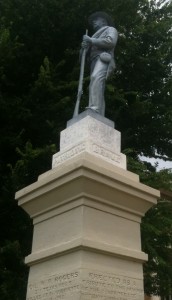 The Confederate solider statue looked out at the Southern city and just stood there. He always just stood there.
The Confederate solider statue looked out at the Southern city and just stood there. He always just stood there.
He saw the tornado hit in 1893. He saw Yellow Fever kill indiscriminately the next year. He saw the fire of 1904. He remembered the celebrations after the Germans and the Japanese were defeated. He laughed at the funny-looking kids who protested the Vietnam war. Recently, he had noticed more people living in the park around him. It reminded him of the the Great Depression. And then there were the pigeons. The damn pigeons. He couldn’t do anything about any of it. He just stood there.
His soul had entered the statue the day he died. It was a few years after the Civil War (or war of Northern Aggression as the tourists liked to call it). The war. The bloody, noisy affair that saw his brother, father, neighbor and best friend all get killed. His home had been burned and his family starved, too. The war. He gazed out at the courthouse square and watched the tourists file by. It was 150 years later and he still couldn’t glamorize it. But they sure did, and that was understandable. They hadn’t seen the rivers of blood at Shiloh. They didn’t have to eat rats in Vicksburg. They didn’t see Jackson go up in flames. They didn’t see their brother’s head evaporate from a cannonball.
He fought to protect his home. Not much glamor in that, really. Every father would do the same. He didn’t go chasing some glamorous lost cause. Slavery was why many of his neighbors had fought; not him. He knew it was wrong from his reading of the Bible. When General Lee laid down his sword, the solider put his arms down, too. He then walked back home to become a small farmer again. For four years, he tried to protect his wife — and in the end, he failed. When he saw her grave that spring day in 1865, his heart was the first part of him that became stone.
Now he was a sentinel over his former hometown. Stone. Cold. Standing there, quietly as the sun came up and the sun went down. He watched as technology changed before his fixed eyes. He remembered the first time a giant iron bird flew over him. And it had been at least 75 years since he had seen a horse. Another pigeon landed on his head. “Oh, here it comes,” he thought. He wished someone would invent a way to get rid of pigeons and their spastic colons.
Being a statue wasn’t fun.
He felt the warmth on his side as his cold, gray stone turned pink. It was sunrise. Another day to stand guard over his home. Another day to watch the world change without him.

Wow. This brought tears to my eyes. Excellent, Marshall.
very nice keep up the good work!
“When he saw her grave that spring day in 1865, his heart was the first part of him that became stone.” Beyond well written!
I agree wholeheartedly
What a wonderful, touching essay!! Your words take my breath away!
Holy crap. You are my Lewis Grizzard replacement. Would love to see you in a newspaper column. Or this blog delivered to my phone when you write it.
Pingback: A collection of my short stories | Marshall Ramsey
As I read each of your musings, I have an urge for more. Each one touches a part of me that has been long neglected. Please, Please start working on a book of your ramblin’ thoughts. Each one is special. Thanks for making my day.
Pingback: North toward Corinth | Marshall Ramsey